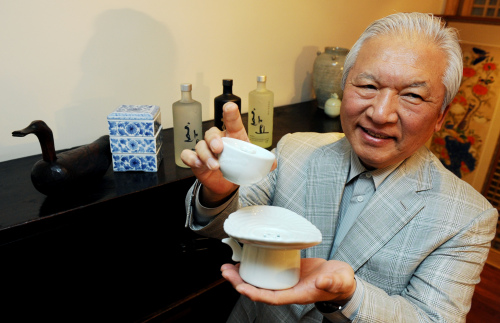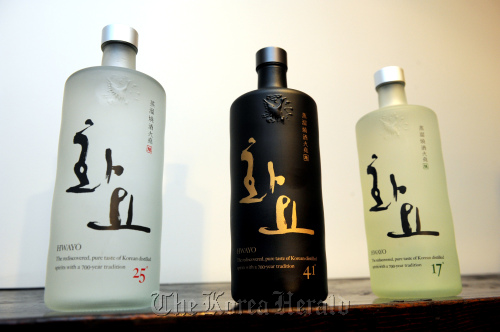Rejection of new interpretations of traditional dishes hamper hansik globalization
The following is the first in a series of articles on the contemporizing of Korean culture -- Ed.
The following is the first in a series of articles on the contemporizing of Korean culture -- Ed.

With societies becoming more affluent, food is no longer just about filling up an empty stomach. Rather it is seen as the very foundation of lifestyle.
“There is a cultural aspect to the simple act of dining. We form relationships, observe good manners, develop a discerning taste,” said Cho Tae-kwon, CEO of KwangJuYo, a company producing high-end porcelain ware.
Cho inherited the company from his father and expanded his business scope to include restaurants and a soju distillery. Gaon, Cho’s fine dining restaurant in the posh area of Sinsa-dong, created quite a stir in the restaurant scene. It was a pioneer in traditional Korean cuisine with a contemporary twist, a showcase for his various business concerns.
Food was elegantly presented in modern and traditional Korean dinnerware by KwangJuYo and high-end soju he developed, Hwayo, filled the cups. Gaon’s version of samgyetang, featuring black spring chicken and high-grade ginseng, sold for over 100,000 won which caused many a gasp. An average samgyetang with regular chicken is priced around 20,000 to 30,000 won, depending on the location of the restaurant.
The restaurant closed down a few years ago due to financial difficulties. Of that venture, Cho says, “It was something that someone had to do.”
Fine dining has emerged as a strong trend in this age of global travel, not limited to the jet-set, and restaurants have become destinations in themselves. Gaon was his answer for Seoul, which he thought lacked a place where foreign visitors could go for excellent food in an elegant atmosphere.
Cho points to the practice of selling fixed menus as a major culprit hindering the development of fine dining in Korea. “It becomes impossible to put value on each dish, each side dish when a whole table of food is sold as a set,” Cho says.

It also leads to restaurateurs competing with each other in terms of the number of dishes that are offered in a set. “It is also responsible for the tremendous waste of food. More than 1.3 trillion won is wasted every year as food garbage,” Cho says.
The notion that banchan, or side dishes, are free should be dispelled, Cho argues. “Putting value to namul (herb) dishes, for example, will create demand for variously priced namul. The story of how namul is picked by hand on the mountainside in springtime will add to the value of namul,” Cho explains.
Koreans also reject new twists to Korean food, another problem Cho encountered at Gaon. This prejudice restricts the development of hansik, he says.
It also hampers globalization of hansik, a cause espoused by the Lee Myung-bak government. Observing that hansik globalization efforts at the moment are event-focused and open to exploitation by those who are in it for government funding, Cho calls for a change in the way the government thinks about globalization of hansik. “Before, we were caught up with how foreigners can enjoy our food. Now, we are sort of demanding that foreigners try our cuisine. We have to think in terms of dining as a cultural activity,” Cho proposes. Hansik globalization involves bringing Korean’s discernment and taste level to par with global standard, according to Cho.
Korea’s many conglomerates should get involved in promoting Korean cuisine on the world stage. “They can open up a 50-seat restaurant for their foreign visitors. Here, the businessmen and businesswomen will have an opportunity to experience Korean food culture at a high level,” explains Cho.
Hansik is also a growth engine for the domestic economy. “By 2030, some 2 billion people will be traveling around the world every year. By 2030, the global food market will be worth 5 quadtrillion won and the restaurant industry will account for about half of that. Where will Korea be?” Cho asks.
The problem with the current state of hansik is that there have been no great changes in the menu since the 1960s. “Look, we export 50 times as much as we did, yet there is no change in our food culture,” says Cho. If the current trend continues, Korea’s cuisine will not make progress despite the growing economy.
People are becoming more adventurous about food and this is an opportunity to present Korean cuisine as culture. “At Momofuku in New York, the Korean-American owner-chef serves ssambap (rice wrapped in vegetables), which is Korean cuisine. Yet foreigners eating ssambap there think they are eating Japanese food. This is the reality,” Cho says.
There is hope yet, according to Cho. “The fact that there is a lot of interest in Korean food is very good,” he adds.
“We are now at a crossroads. In the 1960s it was choosing between export and the domestic market, 1980s required us to make a choice between protectionism and market liberalization. Now we need to make another choice – whether we adopt another culture as the standard or discover and reinterpret our own culture,” says Cho.
Cho is working on a project to open a small restaurant inside the Seoul branch of the National Museum of Contemporary Art which is scheduled to open in 2013 in Samcheong-dong. As he envisions it, the restaurant can be a place to entertain foreigners. It will offer regional and seasonal menus. There will be a story accompanying each dish. “It can serve as a benchmark for other restaurateurs,” he says.
Since 2008 he has been developing and testing dishes at his kitchen. He has invited more than 600 people to his home in Seongbuk-dong, serving his new creations and receiving feedback.
“Developing fine Korean cuisine and drinks is my noblesse oblige. I feel a tremendous sense of crisis. I fear our food culture may disappear,” Cho says.
By Kim Hoo-ran (khooran@heraldcorp.com)









![[Kim Seong-kon] Democracy and the future of South Korea](http://res.heraldm.com/phpwas/restmb_idxmake.php?idx=644&simg=/content/image/2024/04/16/20240416050802_0.jpg&u=)







![[KH Explains] Hyundai's full hybrid edge to pay off amid slow transition to pure EVs](http://res.heraldm.com/phpwas/restmb_idxmake.php?idx=652&simg=/content/image/2024/04/18/20240418050645_0.jpg&u=20240418181020)

![[Today’s K-pop] Zico drops snippet of collaboration with Jennie](http://res.heraldm.com/phpwas/restmb_idxmake.php?idx=642&simg=/content/image/2024/04/18/20240418050702_0.jpg&u=)